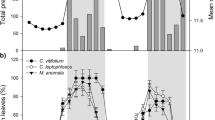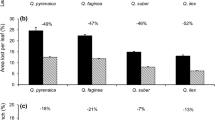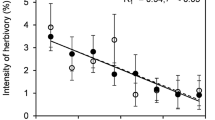Abstract
To determine the degree to which herbivory contributes to phenotypic variation in autumn phenology for deciduous trees, red maple (Acer rubrum) branches were subjected to low and high levels of simulated herbivory and surveyed at the end of the season to assess abscission and degree of autumn coloration. Overall, branches with simulated herbivory abscised ∼7 % more leaves at each autumn survey date than did control branches within trees. While branches subjected to high levels of damage showed advanced phenology, abscission rates did not differ from those of undamaged branches within trees because heavy damage induced earlier leaf loss on adjacent branch nodes in this treatment. Damaged branches had greater proportions of leaf area colored than undamaged branches within trees, having twice the amount of leaf area colored at the onset of autumn and having ∼16 % greater leaf area colored in late October when nearly all leaves were colored. When senescence was scored as the percent of all leaves abscised and/or colored, branches in both treatments reached peak senescence earlier than did control branches within trees: dates of 50 % senescence occurred 2.5 days earlier for low herbivory branches and 9.7 days earlier for branches with high levels of simulated damage. These advanced rates are of the same time length as reported delays in autumn senescence and advances in spring onset due to climate warming. Thus, results suggest that should insect damage increase as a consequence of climate change, it may offset a lengthening of leaf life spans in some tree species.



Similar content being viewed by others
References
Addicott FT (1982) Abscission. University of California Press, Berkeley
Altermatt F (2010) Tell me what you eat and I’ll tell you when you fly: diet can predict phenological changes in response to climate change. Ecol Lett 13:1475–1485
Archetti M (2009) Phylogenetic analysis reveals a scattered distribution of autumn colours. Ann Bot 103:703–713
Ayres MP, Lombardero MJ (2000) Assessing the consequences of global change for forest disturbance from herbivores and pathogens. Sci Total Environ 262:263–286
Blundell AG, Peart DR (2000) High abscission rates of damaged expanding leaves: field evidence from seedlings of a Bornean rain forest tree. Am J Bot 87:1693–1698
Chabot BF, Hicks DJ (1982) The ecology of leaf life spans. Annu Rev Ecol Syst 13:229–259
Chapman SK, Schweitzer JA, Whitham TG (2006) Herbivory differentially alters plant litter dynamics of evergreen and deciduous trees. Oikos 114:566–574
Close DC, Beadle CL (2003) The ecophysiology of foliar anthocyanin. Bot Rev 69:149–161
Dale VH, Joyce LA, McNulty S, Neilson RP, Ayres MP, Flannigan MD, Hanson PJ, Irland LC, Lugo AE, Peterson CJ, Simberloff D, Swanson FJ, Stocks BJ, Wotton BM (2001) Climate change and forest disturbances. Bioscience 51:723–734
Dukes JS, Mooney HA (1999) Does global change increase the success of biological invaders? Trends Ecol Evol 14:135–139
Elliot KJ, Vose JM, Swank WT, Bolstad PV (1999) Long-term patterns in vegetation-site relationships in a southern Appalachian forest. J Torrey Bot Soc 126:320–334
Estrella N, Menzel A (2006) Responses of leaf colouring in four deciduous tree species to climate and weather in Germany. Clim Res 32:253–267
Forkner RE, Marquis RJ, Le Corff J (2008) Timing is everything? Phenological synchrony and population variability in leaf-chewing herbivores of Quercus. Ecol Entomol 33:276–285
Forkner RE, Marquis RJ, Lill JT (2004) Feeny revisited: condensed tannins as anti-herbivore defences in leaf-chewing herbivore communities of Quercus. Ecol Entomol 29:174–187
Forkner RE, Marquis RJ, Lill JT, Le Corff J (2006) Impacts of alternative timber harvest practices on leaf-chewing herbivores of oak. Conserv Biol 20:429–440
Garcia-Plazaola JI, Hernandez A, Becerril JM (2003) Antioxidant and pigment composition during autumnal leaf senescence in woody deciduous species differing in their ecological traits. Plant Biol 5:557–566
Hodar JA, Zamora R (2004) Herbivory and climatic warming: a Mediterranean outbreaking caterpillar attacks a relict, boreal pine species. Biodivers Conserv 13:493–500
Hunter AF, Elkinton JS (2000) Effects of synchrony with host plant on populations of a spring-feeding Lepidopteran. Ecology 81:1248–1261
Hunter MD (1990) Differential susceptibility to variable plant phenology and its role in competition between two insect herbivores on oak. Ecol Entomol 15:401–408
Ibanez I, Primack RB, Miller-Rushing AJ, Ellwood E, Higuchi H, Lee SD, Kobori H, Silander JA (2010) Forecasting phenology under global warming. Philos Trans B 365:3247–3260
Jepsen JU, Kapari L, Hagen SB, Schott T, Vindstad OPL, Nilssen AC, Ims RA (2011) Rapid northwards expansion of a forest insect pest attributed to spring phenology matching with sub-Arctic birch. Glob Chang Biol 17:2071–2083
Karban R (2007) Leaf drop in evergreen Ceanothus velutinus as a means of reducing herbivory. Ecology 89:2446–2452
Killingbeck KT (2004) Nutrient resorption. In: Nooden LD (ed) Plant cell death processes. Elsevier, San Diego, pp 215–226
Lee DW (2002) Anthocyanins in autumn leaf senescence. Adv Bot Res 37(37):147–165
Lehtila K, Boalt E (2004) The use and usefulness of artificial herbivory in plant-herbivore studies. In: Weisser WW, Siemann E (eds) Insects and ecosystem function. Springer, Berlin, pp 257–275
Logan JA, Regniere J, Powell JA (2003) Assessing the impacts of global warming on forest pest dynamics. Front Ecol Environ 1:130–137
Lowman MD (1992) Leaf growth dynamics and herbivory in 5 species of australian rain-forest canopy trees. J Ecol 80:433–447
Marquis RJ, Passoa S (1989) Seasonal diversity and abundance of the herbivore fauna of striped maple Acer pensylvanicum L. (Aceraceae) in western Virginia. Am Midl Nat 122:313–320
Marquis RJ, Whelan CJ (1994) Insectivorous birds increase growth of white oak through consumption of leaf-chewing insects. Ecology 75:2007–2014
Matsuki S, Koike T (2006) Comparison of leaf life span, photosynthesis and defensive traits across seven species of deciduous broad-leaf tree seedlings. Ann Bot 97:813–817
Menzel A, Estrella N, Heitland W, Susnik A, Schleip C, Dose V (2008) Bayesian analysis of the species-specific lengthening of the growing season in two European countries and the influence of an insect pest. Int J Biometeorol 52:209–218
Myneni RB, Keeling CD, Tucker CJ, Asrar G, Nemani RR (1997) Increased plant growth in the northern high latitudes from 1981 to 1991. Nature 386:698–702
Ougham HJ, Morris P, Thomas H (2005) The colors of autumn leaves as symptoms of cellular recycling and defenses against environmental stresses. Curr Top Dev Biol 66:135–160
Quiring DT, McKinnon ML (1999) Why does early-season herbivory affect subsequent budburst? Ecology 80:1724–1735
Reich PB, Ellsworth DS, Walters MB, Vose JM, Gresham C, Volin JC, Bowman WD (1999) Generality of leaf trait relationships: a test across six biomes. Ecology 80:1955–1969
Reich PB, Uhl C, Walters MB, Prugh L, Ellsworth DS (2004) Leaf demography and phenology in Amazonian rain forest: a census of 40 000 leaves of 23 tree species. Ecol Monogr 74:3–23
Risley LS (1993) Effect of simulated insect herbivore damage on survival of tree leaves. Environ Entomol 22:57–61
Risley LS, Crossley DAJ (1988) Herbivore-caused greenfall in the southern appalachians. Ecology 69:1118–1127
SAS (2008) SAS for Windows, Version 9.2. SAS Institute, Cary
Schaberg PG, Murakami PF, Turner MR, Heitz HK, Hawley GJ (2008) Association of red coloration with senescence of sugar maple leaves in autumn. Tree-Struct Funct 22:573–578
Schäfer M, Fischer C, Meldau S, Seebald E, Oelmüller R, Baldwin IT (2011) Lipase activity in insect oral secretions mediates defense responses in Arabidopsis. Plant Physiol 156:1520–1534
Singer MC, Parmesan C (2010) Phenological asynchrony between herbivorous insects and their hosts: signal of climate change or pre-existing adaptive strategy? Philos Trans B 365:3161–3176
Sinkkonen A (2006) Sexual reproduction advances autumn leaf colours in mountain birch (Betula pubescens ssp czerepanovii). J Evol Biol 19:1722–1724
Sparks TH, Menzel A (2002) Observed changes in seasons: an overview. Int J Climatol 22:1715–1725
Strode PK (2003) Implications of climate change for North American wood warblers (Parulidae). Glob Chang Biol 9:1137–1144
Tikkanen OP, Lyytikainen-Saarenmaa P (2002) Adaptation of a generalist moth, Operophtera brumata, to variable budburst phenology of host plants. Entomol Exp Appl 103:123–133
Tucker CJ, Slayback DA, Pinzon JE, Los SO, Myneni RB, Taylor MG (2001) Higher northern latitude normalized difference vegetation index and growing season trends from 1982 to 1999. Int J Biometeorol 45:184–190
Vitasse Y, Porte AJ, Kremer A, Michalet R, Delzon S (2009) Responses of canopy duration to temperature changes in four temperate tree species: relative contributions of spring and autumn leaf phenology. Oecologia 161:187–198
Wold EN, Marquis RJ (1997) Induced defense in white oak: effects on herbivores and consequences for the plant. Ecology 78:1356–1369
Wolkovich EM, Cleland EE (2011) The phenology of plant invasions: a community ecology perspective. Front Ecol Environ 9:287–294
Zhang X, Goldberg MD (2011) Monitoring fall foliage coloration dynamics using time-series satellite data. Remote Sens Environ 115:382–391
Acknowledgments
I would like to thank Caitlin Cutler for assistance in the field. This project was funded in part by a George Mason University Provost Summer Research Fellowship.
Author information
Authors and Affiliations
Corresponding author
Rights and permissions
About this article
Cite this article
Forkner, R.E. Simulated herbivory advances autumn phenology in Acer rubrum . Int J Biometeorol 58, 499–507 (2014). https://doi.org/10.1007/s00484-013-0701-8
Received:
Revised:
Accepted:
Published:
Issue Date:
DOI: https://doi.org/10.1007/s00484-013-0701-8




